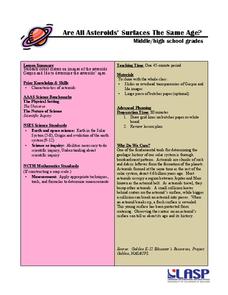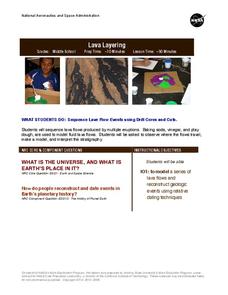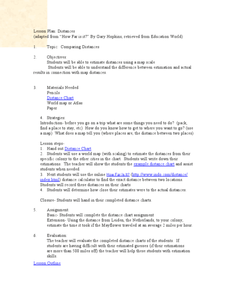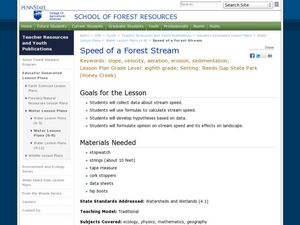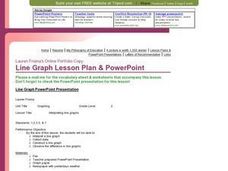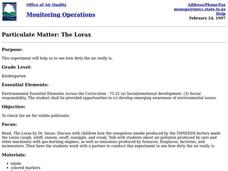Curated OER
Individualizing
Students practice reading maps as they plan a day trip. Using the internet, they select a destination of their choice and choose a place to stop along their journey. They write an explanation on why they want to visit the place to end...
Curated OER
Imaginary Trip to South Korea
Students "visit" South Korea through the use of technology, in a fun, and stimulating, detailed project. They arrange travel, make choices, work through a budget, learn history, have exposure to language, and get a sense of what a...
Curated OER
Linear Motion
In this fantastic physics and math lesson, student pairs create a ramp that will transport a rolling marble in order to learn about linear motion. Students use cardboard, straws, toothpicks, marshmallows, and paper clips in order to make...
Curated OER
Striking It Rich!
Fifth graders explore the California Gold Rush. They explore the lure of gold and the Wild West, how pioneers traveled to the West, and the hardships and people they encountered along the way. Activities be authentic, hands-on, and...
Curated OER
Engineering Pop-Ups
Young scholars explore the art of paper engineering and pop-up-books. They listen to a teacher-led lecture on pop-up books, discuss the process of paper engineering, and plan, design and construct an original pop-up book.
Curated OER
Sun and Shadows
Why do shadows look different in the summer than in the winter? What causes day and night? How can a sundial be used to tell time? Answer these questions and more through two engaging lessons about light and shadows. Fourth and fifth...
University of Colorado
Are All Asteroids' Surfaces the Same Age?
Did you know scientists can tell the age of an asteroid by looking closely at its craters? This final lesson of a six-part series focuses on two asteroids, Gaspra and Ida, in order to demonstrate the concept of dating asteroids. Scholars...
Teach Engineering
Restriction Enzymes and DNA Fingerprinting
Show your class why restrictions aren't always a bad thing. In the third segment of a four-part series, the instructor develops the idea of restriction enzymes. Pupils learn how scientists use restriction enzymes in DNA analysis and DNA...
NASA
Lava Layering
Take the old baking soda and vinegar volcano to the next level by using it to study repeated lava flows over time, examine geologic features on Earth and Mars, and speculate about some of the formations on Mars.
Curated OER
Savings and Earnings
Fifth graders complete several activities to learn about earning, budgeting, and saving money. In this saving money lesson, 5th graders read a book about saving money and complete a 'Savings and Earnings' worksheet. Students work in...
Curated OER
Comparing Distances
Students practice estimating distances by analyzing a map. In this length measurement lesson plan, students view a map with a distance key and use their measurement skills to estimate the distance between two cities. Students utilize an...
Curated OER
Speed of a Forest Stream
Students study stream speed. In this stream speed lesson students complete an activity and formulate an opinion and study its effects.
Curated OER
Exquisite Excursions
Young scholars locate 6 cities, one on each of the 6 major continents. They find distance for each leg of their journey, convert to percents, use a time zone map, and convert to foreign currencies.
Alabama Learning Exchange
Poppin' For Popcorn!
Students graph data from different popcorn flavors. For this graphing lesson, students make graphs using an assigned web site after collecting data about the flavors of popcorn that fellow classmates prefer.
Alabama Learning Exchange
Creating a Reflection
Investigate geometric reflections in this geometry lesson. Create geometric reflections that show the reflection across the x and y axis of a coordinate graph. Learners watch a teacher demonstration before proceeding on their own. They...
Alabama Learning Exchange
Inch by Inch
Third graders listen to a read-aloud of Leo Lionni's, Inch by Inch before measuring a variety of items using both standard and metric units. They record the measurement data and follow a recipe for dirt pie.
Curated OER
Migration of the Neo-Tropical Songbirds
Fifth graders plot the migration of birds using Google Earth. For this lesson on bird migration, 5th graders work in groups to plot the migration of a group of birds using Google Earth. Students present and discuss their findings and...
Curated OER
Jet Who?
Students explore the emerging budget flight industry and the resulting increased competition among airlines. They compare a budget airline with a legacy carrier in terms of cost, corporate profile, flight statistics, amenities, and...
Curated OER
Follow the Leaders
Students research the famous Alaskan Iditarod Dog Team Race. They read biographies of notable 'mushers', choose one of 70+ teams and track the daily mileage and location. They keep a journal to record their findings.
Curated OER
Interpreting Line Graphs
Fifth graders interpret line graphs. In this graphing lesson, 5th graders first begin by reviewing the difference in bar and line graphs and what they are used for. Students practice interpreting the data on various line graphs and using...
Curated OER
Network This
Students determine the number of paths in a network with up to six vertices. They construct a network to solve a problem situation. They describe and defend the solution to a network problem.
Curated OER
Particulate Matter: The Lorax
Students explore air pollution. In this ecology lesson, students participate in an experiment in which 5 numbered jar lids are placed outside. Students bring one lid a day in until all jars are inside. Dirt specks are counted, observed,...
Curated OER
Manatee Endangered
High schoolers (or middle schoolers) research the endangered manatee and the Endangered Species Act. They choose a local animal that is threatened or endangered and attempt to find out what is being done to protect it. Short, but sweet,...
Curated OER
Nim: A Game Played All Over the World
Students participate in a European subtraction game. In this subtraction lesson, students use pebbles to demonstrate different subtraction strategies. The students use a deduction strategy to be the first one left with no pebbles.






